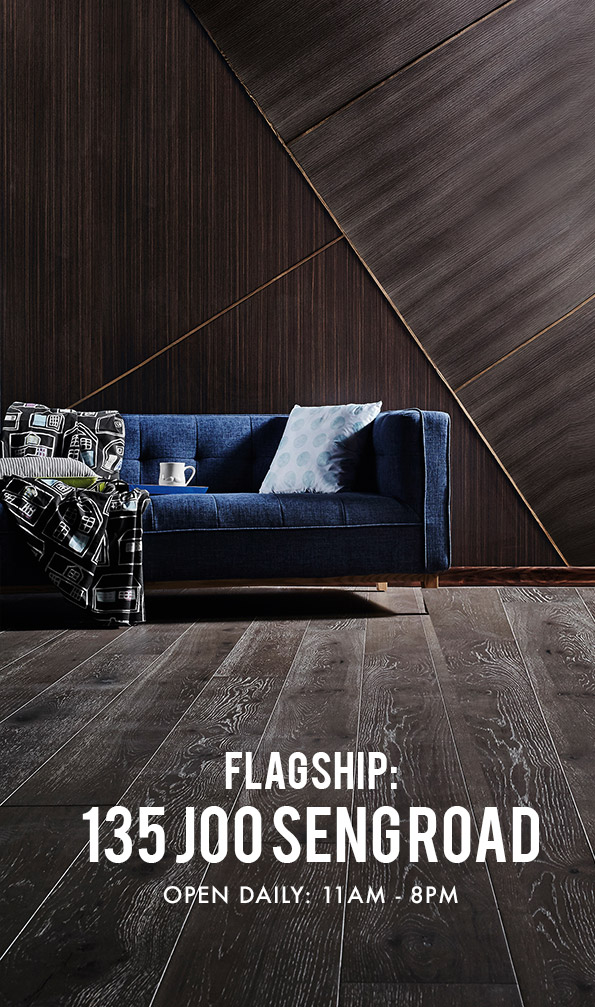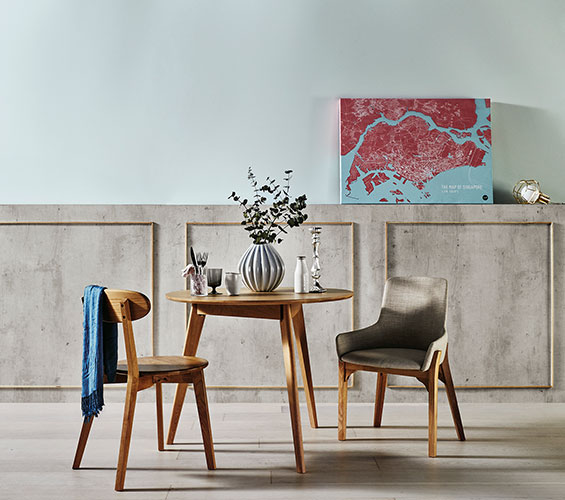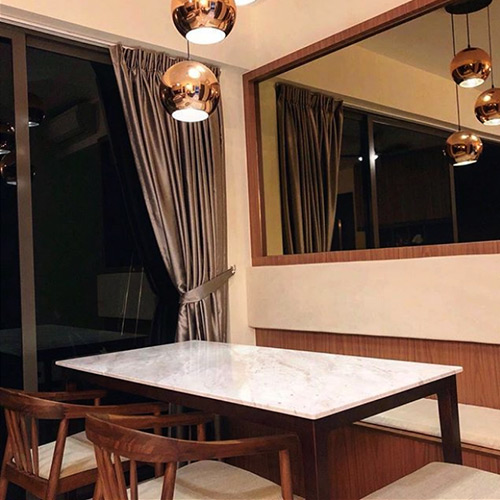How to Choose the Right Furniture for Your Home
To choose the right furniture for your home, start by defining your style. Think modern, traditional, or anything in between that vibes with your home's architecture. Next, measure your space. Knowing your room's dimensions guarantees everything fits perfectly and maintains a good flow. Material matters too—opt for durability and aesthetics that match your lifestyle, whether it's hardwood for elegance or metal for a modern touch. Don't forget about comfort; test pieces for cozy sits and peaceful sleeps. Remember, the right scale and proportion will harmonize your space. As you blend these elements, your home will gradually reveal its transformed self.

Define Your Style
Before exploring the vast world of online furniture shopping, it's crucial to first identify your personal style, ensuring that each piece not only serves its purpose but also reflects the essence of who you're and the atmosphere you wish to create in your home. Start by exploring various design styles - are you drawn to the clean lines of modern furniture, the warmth of traditional pieces, or perhaps the rustic charm of farmhouse decor? Your home's existing architecture and decor can offer clues. A sleek, minimalist apartment might call for contemporary pieces, while a cottage with hardwood floors screams for vintage or rustic choices.
Next, consider the mood you're aiming to set. Do you want your space to feel cozy and inviting, with soft fabrics and warm colors, or would you prefer a more formal ambiance, with elegant, structured pieces? This is where functionality meets aesthetics. You're not just filling a room; you're curating an environment that enhances your daily life. Whether you're creating a serene retreat or a vibrant space for entertaining, your furniture selections are the foundation of your home's character.
Measure and Plan
Once you've identified your style, it's crucial to measure your space and sketch a preliminary floor plan to make sure your furniture choices harmonize with the room's dimensions and layout. You'll want to grab a tape measure and meticulously record the length, width, and even the height of your room. Remember, it's not just about the floor space; consider windows, doorways, and any built-ins that could influence the placement and size of your furniture.
With measurements in hand, it's time to draft a floor plan. You can go old-school with graph paper and pencil or use a digital tool that lets you drag and drop furniture pieces into place. This step isn't just about fitting pieces into a puzzle; it's about envisioning your daily life in this space. Think about the flow of movement between rooms, how doors open, and where natural light falls during the day.
Consider how you'll use each piece of furniture. Will the sofa face a TV or fireplace? Is there ample room around the dining table for chairs to slide out? Planning with these details in mind ensures a functional, beautiful space that feels like it was tailor-made for you.
Choose the Right Materials
After mapping out your space and understanding how each piece will fit and function, it's time to focus on selecting the right materials for your furniture, a decision that impacts both the look and longevity of your pieces. Choosing materials isn't just about aesthetics; it's about finding a harmony between beauty and durability. Wood offers a timeless appeal and robustness, suitable for pieces like tables and cabinets. However, consider the type of wood; hardwoods are more durable, while softwoods can be more affordable but less resistant to wear.
Metal furniture, with its sleek lines, can introduce a modern vibe into your space. It's particularly suitable for items that need to withstand heavy use, making it an excellent choice for dining chairs or bed frames.
Meanwhile, upholstery materials bring comfort and color into the room. Opt for fabrics that align with your lifestyle; if you have pets or children, look for stain-resistant and durable fabrics like microfiber or leather.
Prioritize Comfort
When selecting furniture for your home, always prioritize comfort, as it's the cornerstone of a truly welcoming and functional living environment. Imagine sinking into a plush sofa after a long day or resting your head on a pillow-top mattress that seems to conform perfectly to your body. These are the moments that transform a house into a home. Comfort isn't just about how a piece feels, though; it's deeply intertwined with how it functions in your space and enhances your lifestyle.
Choose seating that supports your back and neck, especially if you spend significant time reading or watching TV. Consider the height and depth of chairs and sofas, making sure they cater to the varying needs of everyone in your household. For the bedroom, invest in a high-quality mattress and pillows that encourage a good night's sleep, aligning with your personal preferences, whether that's firm support or a softer, cloud-like feel.
Materials also play a vital role in comfort. Natural fabrics like cotton and linen offer breathability and softness, while leather can add a touch of luxury and is simple to clean. Always test furniture before purchasing to confirm it meets your comfort criteria, creating a sanctuary where relaxation is inevitable.
Scale and Proportion
Understanding the principles of scale and proportion is essential as you select furniture that harmonizes with the size of your rooms. It's about finding that perfect balance where each piece contributes to a cohesive look without overwhelming or disappearing in the space.
Imagine a massive sectional in a tiny living room; it'd swallow the space whole. Conversely, a petite coffee table in a grand living room can look lost and insignificant.
You'll want to start by considering the room's dimensions. A large, airy room can handle stout, substantial furniture, while a small room benefits from sleeker, more proportionate pieces. It's not just about the size, though. The shape of furniture plays a role in creating a balanced aesthetic.
A tall, narrow bookcase might complement the high ceilings in a room, drawing the eye upward and making the space feel larger.
Accent Pieces
Having explored the significance of scale and proportion, it's time to accentuate your space with unique accent pieces that reflect your personal style and add depth to your décor. Accent pieces are more than just furniture; they're expressions of your unique aesthetic and functional needs. Whether it's a vibrant throw pillow, an antique vase, or a modern sculpture, these elements bring life and character to your home.
| Piece | Functionality | Aesthetic Value |
|---|---|---|
| Statement Chair | Comfortable seating; conversation starter | Bold design; color pop |
| Artistic Vase | Holds flowers; can be a standalone piece | Texture; shape; material |
| Decorative Mirror | Reflects light; adds depth | Frame design; placement |
Choosing the right accent pieces involves a delicate balance between functionality and style. You'll want items that not only look beautiful but also serve a purpose or enhance the overall comfort of your space. Consider the material and color of each piece and how it complements your existing décor. Remember, the goal is to create a cohesive yet dynamic environment where each element contributes to the ambience you're aiming for. Let your personality lead the way in selecting accents that resonate with you and your lifestyle.
Budget Considerations
Before delving into the world of furniture shopping, it's crucial to first establish a realistic budget that mirrors your financial comfort zone and design aspirations. Start by evaluating your finances and determining how much you're willing to spend. This doesn't mean you have to compromise on style or quality. With a bit of research, you can find stunning pieces that won't break the bank.
Consider exploring secondhand options or DIY projects to add a personal touch to your space while keeping costs low. Look for furniture sales, clearance items, or discount stores that offer stylish yet affordable pieces. Remember, investing in high-quality, timeless pieces for rooms like the living room or bedroom can save you money in the long run, as these items tend to withstand daily wear and tear better than cheaper alternatives.
Prioritize your purchases by focusing on essential pieces first. A comfortable sofa, a sturdy dining table, and a supportive mattress are worth investing in upfront. You can always add accent pieces and decorations over time as your budget allows. This approach guarantees you don't overspend early on, leaving room for thoughtful additions that truly make your house feel like home.
Conclusion
In wrapping up, remember that choosing the right furniture is about striking a balance between beauty and practicality. It's about reflecting your style while ensuring comfort and functionality in your daily life.
Measure carefully, prioritize materials that blend durability with aesthetics, and don't overlook the importance of scale and proportion.
Let accent pieces inject personality, and always keep your budget in check. By following these guidelines, you'll transform your space into a haven that's as stylish as it's welcoming.



